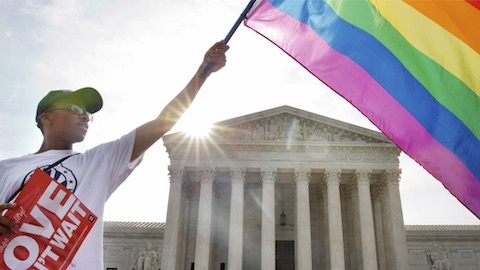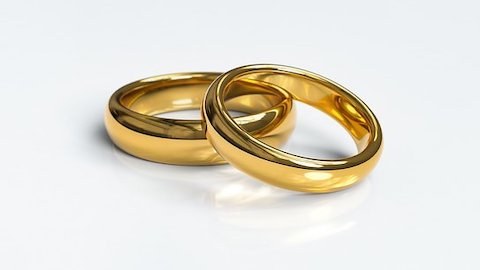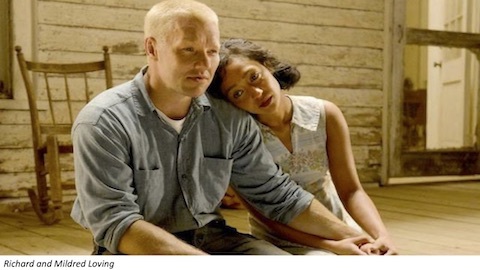Love and Marriage

“We didn’t set out to make history. We just fell in love.” Sharni Edwards and Robyn Peoples became the first gay couple to wed in Northern Ireland when they took their vows on February 11, 2020, 6 years to the day after they first met. The women’s nuptials were made possible by a hard-fought Love Equality campaign, which ended with Northern Ireland becoming the 28th country in the world to legalize same-sex marriage (Same-sex marriage, 2020).
Sharni’s sentiment—that she and Robyn simply fell in love, like countless couples throughout time—could just as easily describe the feelings of Richard Loving and Mildred Jeter, a young couple who grew up in rural Virginia in the 1950s. After meeting at a local dance, they dated for a few years, got married and were just settling down to their lives together when a warrant was served for their arrest. Their crime? Richard was White, and Mildred had Black and Native American ancestry. Their marriage violated a Virginia law that deemed it a felony—punishable by up to 5 years in prison--to marry across the color line (Walker, 2017).
It would take a lengthy legal battle stretching all the way to the Supreme Court for the Lovings to live in peace as a married couple in Virginia. Finally, the U.S. Supreme Court struck down laws against interracial marriage in the aptly titled case, Loving v. Virginia, on June 12, 1967—10 days after the couple’s 9th wedding anniversary. Like Sharni and Robyn, Richard and Mildred were just two people who fell in love—until they ended up making history. Years later, Mildred reflected, “[Our intent] wasn’t to make a political statement or start a fight. We were in love, and we wanted to be married” (Mildred Loving, 40 years later, 2007).

Two movements, same goal
Two love stories. Two milestones. What can they tell us about the intersections between two struggles for equality? The civil rights and LGBTQ+ equality movements are deeply interconnected, with many shared strategies, tactics and goals.
Filmmaker Yoruba Richen explores these connections and borrowings in a recent Ted Talk. She draws a line from the famed 1955 bus boycott in Montgomery to the Stonewall Rebellion in New York City in 1969, and between the March on Washington in 1963 and a series of seminal gay rights marches that took place between the 1970s and the 1990s. Richen calls these milestones in Black and LGBTQ+ activism the “I’m tired of your foot on my neck strategy” and the “We are visible and many in numbers strategy” (Richen, 2014).
And then there’s the “Loving strategy.” We often think of the Civil Rights Movement in terms of battles to desegregate schools or ensure Black voting rights. But the struggle for racial equality in the 1950s and 1960s occurred on numerous fronts, including efforts to make interracial marriage legal. That’s a story worth recalling here, because the fight to legalize interracial marriage helped pave the way for same-sex marriage. Indeed, it’s in the struggle to openly acknowledge and legitimize love—across the color line and for same-sex couples—that we most clearly see the interconnections, the borrowings and the shared values of the two movements.

Establishing the right to marry
Laws banning interracial marriage—known as anti-miscegenation laws--had their roots in the establishment of slavery in the 1600s. After slavery ended, states continued to prohibit interracial relationships in an effort to shore up white supremacy. The first successful legal challenge to an anti-miscegenation law came in 1948, when the Supreme Court of California ruled in favor of the plaintiffs, a Black man and a Mexican American woman (legally classified as white), who sued the state after they were denied a marriage license. Significantly, the California court held that marriage was a fundamental right that could not be denied by the states on the basis of prejudice (Mangrum, 2017).
The California case only pertained to laws in that state. It would take another 19 years—and the mounting of a sustained and effective national civil rights movement—for all such laws to be eradicated by the Supreme Court in Loving v. Virginia. That majority opinion echoed and expanded on the California court’s assertion that laws against interracial marriage were in violation of due process and the equal protection clause of the 14th Amendment. “The freedom to marry has long been recognized as one of the vital personal rights essential to the orderly pursuit of happiness by free men . . . To deny this fundamental freedom on so insupportable basis . . . is surely to deprive . . . citizens of liberty without due process of law” (Duigan, 2016).

From Stonewall to Marriage Equality
Just one year after gay and transgender patrons at the Stonewall Inn bar in New York rebelled against police harassment and brutality, launching the modern gay rights movement, law student Richard Baker and librarian James McConnell applied for a marriage license in Minnesota. The local clerk rejected the couple’s application on the basis that they were both men. Baker and McConnell sued, but the Minnesota courts upheld the clerk’s rejection of their application, and the U.S. Supreme Court declined to hear the case (Compton, 2019).
Over the next two decades, the movement for gay marriage made very little headway, and numerous states created laws that explicitly defined marriage as a union between men and women. Then came an even bigger blow. In 1996, Congress passed the Defense of Marriage Act (DOMA), which was signed into law by President Bill Clinton. This was a serious setback for the marriage equality movement, as the law stipulated that only heterosexual couples would be eligible for federal benefits, such as joint filing of income taxes and spousal social security payments, even if they lived in a state that made gay marriage legal.
With DOMA enacted, the battle over gay marriage raged, a lightning rod in the nation’s perpetual culture wars. Some states moved to legalize same-sex marriage; others enacted new bans. Then, in 2010, Edith Windsor sued the federal government after her wife, Thea Spyer, passed away. Spyer left her estate to Windsor, but because the federal government did not recognize Windsor as the surviving spouse, she had to pay substantial estate taxes. In response to Windsor’s lawsuit, the Obama administration announced that the federal government would no longer defend DOMA. This opened the door for further challenges, culminating in the 2015 Supreme Court case, Obergefell vs. Hodges, which legalized same-sex marriage throughout the country (Dwyer, 2017).

The freedom to marry
Throughout the fight for same-sex marriage, advocates drew on the prior struggle to legitimize interracial relationships. They frequently cited Loving and other cases as precedent and amplified the argument that love and marriage were too deeply personal and fundamental to human happiness to be refused on account of prejudice. Time and again, proponents of gay marriage drew attention to the hardships faced by loved ones who were denied such basic rights as the ability to be at the bedside of a loved one who lay dying or provide security for their children—rights that had similarly been denied to interracial couples for centuries.
The courts, too, cited the legalization of interracial relationships as precedent for legitimizing same-sex couples. The Obergefell v. Hodges decision invoked Loving nearly a dozen times, and the majority opinion, authored by Justice Anthony Kennedy, clearly recalled earlier arguments on behalf on interracial marriage. Kennedy wrote,
No union is more profound than marriage, for it embodies the highest ideals of love, fidelity, devotion, sacrifice, and family. In forming a marital union, two people become something greater than once they were. As some of the petitioners in these cases demonstrate, marriage embodies a love that may endure even past death. It would misunderstand these men and women to say they disrespect the idea of marriage. Their plea is that they do respect it, respect it so deeply that they seek to find its fulfillment for themselves. Their hope is not to be condemned to live in loneliness, excluded from one of civilization's oldest institutions. They ask for equal dignity in the eyes of the law. The Constitution grants them that right (Obergefell v. Hodges, 2015).
Sadly, Richard Loving died in a car accident in 1975—he and Mildred had just 8 years together after the Supreme Court overturned the laws that sought to separate them. Mildred Loving passed away in 2008, so she did not live to witness the U.S. victory for same-sex marriage. But she felt a deeply personal connection to that movement, which she saw as inextricably bound up with her own journey. On the 40th anniversary of Loving v. Virginia, she reflected,
I am still not a political person, but I am proud that Richard’s and my name is on the court case that can help reinforce the love, the commitment, the fairness, and the family that so many people, black or white, young our old, gay or straight seek in life. I support the freedom to marry for all. That’s what Loving, and loving, are all about (Mildred Loving, 40 years later, 2007).
Amen to that.
About the author--Kathleen Clark is Chief Learning Officer of Identiversity Inc. She lives with her family in Charlotte, NC and writes widely on topics relating to diversity, equity and inclusion.
References:
The Atlantic. (2007, June 18). Mildred Loving, 40 Years Later. https://www.theatlantic.com/daily-dish/archive/2007/06/mildred-loving-40-years-later/227582/
BBC News. (2020, February 11). Same-sex marriage: Couple make history as first in NI. https://www.bbc.com/news/uk-northern-ireland-51466588
Compton, Julie. (2019, March 7). After decades-long legal battle, gay couple's 1971 marriage officially recognized. NBC. https://www.nbcnews.com/feature/nbc-out/after-decades-long-legal-battle-gay-couple-s-1971-marriage-n...
Duigan, Brian. (2016, November 16). Loving v. Virginia. Britannica. https://www.britannica.com/event/Loving-v-Virginia
Dwyer, Colin. (2017, September 12). Edith Windsor, LGBTQ advocate who fought the Defense of Marriage Act, Dies at 88. NPR. https://www.npr.org/sections/thetwo-way/2017/09/12/550502373/edith-windsor-lgbtq-advocate-who-fought...
Mangrum, Erik. (2017, June 12). Before Loving. PBS. https://www.pbs.org/wgbh/americanexperience/features/before-loving/
Obergefell v. Hodges. (2015, June 26). Legal Information Institute of Cornell Law School. https://www.law.cornell.edu/supremecourt/text/14-556#writing-14-556_OPINION_3
Richen, Yoruba. (2014). What the gay rights movement learned from the civil rights movement [Video]. TED Conferences. https://www.ted.com/talks/yoruba_richen_what_the_gay_rights_movement_learned_from_the_civil_rights_m...
